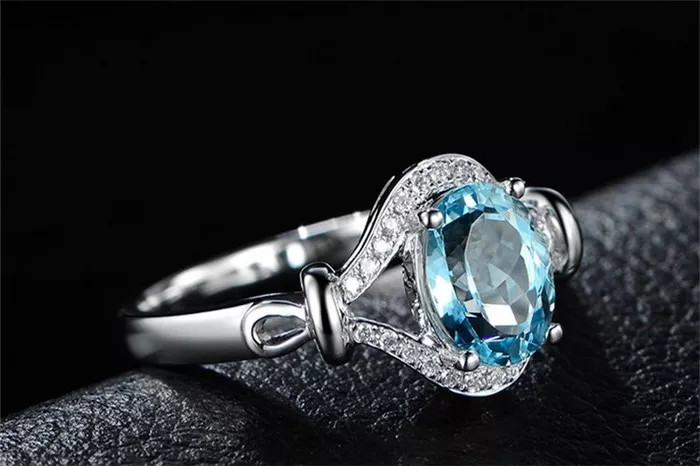Aquamarine, with its serene blue hues, has long been cherished for its beauty and mystical aura. This gemstone has captured the hearts of many, both for its aesthetic appeal and its supposed metaphysical properties. However, in the realm of gemstones, the line between natural and synthetic can sometimes blur, leading to confusion among buyers. This article aims to provide a detailed and easy-to-understand comparison between natural and synthetic aquamarine, helping readers make informed decisions.
Understanding Natural Aquamarine
Natural aquamarine is a type of beryl, a mineral that forms under specific geological conditions over millions of years. It is renowned for its transparent to semi-transparent blue color, ranging from pale to deep shades. This color is primarily due to the presence of iron in its crystal structure.
Formation Process
Natural aquamarine forms in pegmatite rocks, which are coarse-grained igneous rocks found in the Earth’s crust. The formation process begins when beryllium, aluminum, silicon, and oxygen, combined with trace elements like iron, undergo crystallization under high pressure and temperature conditions. Over time, these elements solidify into crystals, which, if rich in iron, turn into aquamarine.
Unique Characteristics
Each natural aquamarine gemstone is unique, displaying variations in color, clarity, and cut. These variations add to the charm and value of the gemstone. Natural aquamarine often has natural inclusions, such as liquid-filled cavities or tiny mineral crystals, which serve as proof of its natural origin.
Value and Rarity
Natural aquamarine’s value depends on several factors, including color saturation, clarity, size, and cut. Deep, vivid blue aquamarines with high clarity are the most sought-after and command higher prices. The rarity of a specific piece can also significantly impact its value.
Introducing Synthetic Aquamarine
Synthetic aquamarine, on the other hand, is created in a laboratory through a process that mimics the natural formation conditions but on a much faster scale. While it possesses similar physical and optical properties to natural aquamarine, there are distinct differences.
Laboratory Synthesis
The synthesis of aquamarine involves a complex process called flux growth or hydrothermal synthesis. In flux growth, a molten flux material is used to dissolve the necessary raw materials (beryllium, aluminum, silicon, and oxygen) under controlled conditions. The solution is then cooled slowly, allowing crystals to form. Hydrothermal synthesis uses high-pressure, high-temperature environments to simulate the natural conditions under which aquamarine forms.
Consistency and Uniformity
Synthetic aquamarine often exhibits greater consistency and uniformity in color, clarity, and size compared to natural stones. This uniformity is a result of the controlled environment in which the gemstones are grown. While some collectors may prefer the natural variations found in natural gemstones, others appreciate the predictability of synthetic ones.
Ethical and Environmental Considerations
The production of synthetic aquamarine avoids the environmental impact and ethical concerns associated with mining natural gemstones. Mining can lead to deforestation, soil erosion, and disruption of local ecosystems. Additionally, synthetic gemstones provide a sustainable option, as they can be produced in large quantities without depleting natural resources.
Identifying the Difference
Distinguishing between natural and synthetic aquamarine can be challenging, especially for the untrained eye. However, there are several methods and techniques that professionals use to determine the origin of a gemstone.
Visual Inspection
While both natural and synthetic aquamarine share similar color and clarity, a trained eye may notice subtle differences in the gemstone’s appearance. Synthetic aquamarine may exhibit a more perfect clarity, with fewer natural inclusions or imperfections.
Spectroscopic Analysis
Spectroscopic analysis, such as absorption spectroscopy, can reveal the presence of specific chemical impurities or trace elements that differentiate natural and synthetic aquamarine. Each type of gemstone absorbs light at specific wavelengths, creating a unique spectral fingerprint.
Density and Refractive Index
Physical properties like density and refractive index can also provide clues. Synthetic aquamarine may have slightly different values compared to natural stones due to variations in the crystallization process.
Heat Conductivity
Thermal conductivity testing is another method. Natural aquamarine typically has a lower thermal conductivity than synthetic materials, which can be measured using specialized instruments.
Market Trends and Consumer Preferences
The market for both natural and synthetic aquamarine is driven by consumer preferences, which can vary significantly based on region, culture, and personal beliefs.
Natural Aquamarine Market
Natural aquamarine continues to be popular among collectors and jewelry enthusiasts who value the uniqueness and rarity of naturally occurring gemstones. Its association with the sea and serenity makes it a favorite for engagement rings, pendants, and other jewelry pieces.
Synthetic Aquamarine Market
Synthetic aquamarine appeals to consumers who prioritize affordability, sustainability, and consistency. As awareness of the environmental impact of mining grows, synthetic gemstones are becoming increasingly popular as a more ethical alternative.
The Role of Technology
Advancements in technology have made it easier to produce high-quality synthetic gemstones that rival natural ones in appearance. This has led to a rise in the availability and accessibility of synthetic aquamarine, further influencing consumer choices.
Conclusion
In conclusion, both natural and synthetic aquamarine offer their own unique charm and appeal. Natural aquamarine, with its natural variations and rarity, continues to be cherished by collectors and jewelry lovers. Synthetic aquamarine, on the other hand, provides a sustainable, affordable, and consistent alternative that appeals to a growing market of ethically conscious consumers.
Related topic:
- What Is Aquamarine Stone Used For?
- How to Tell Real Aquamarine from Fake
- JCPenney Aquamarine Rings: A Buyer’s Guide


